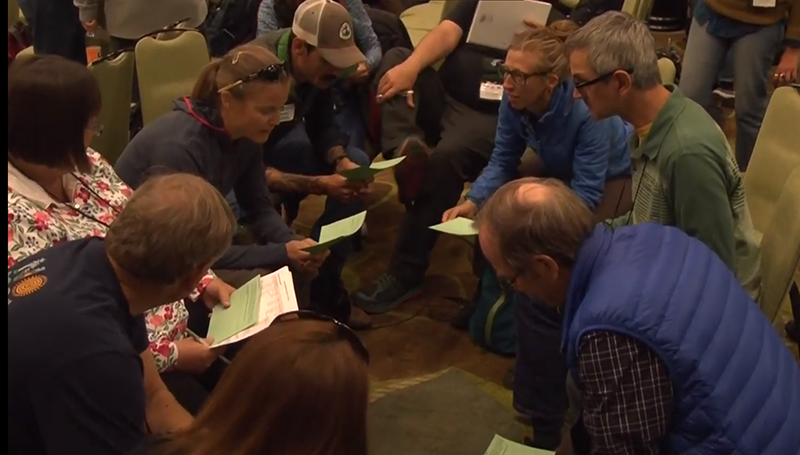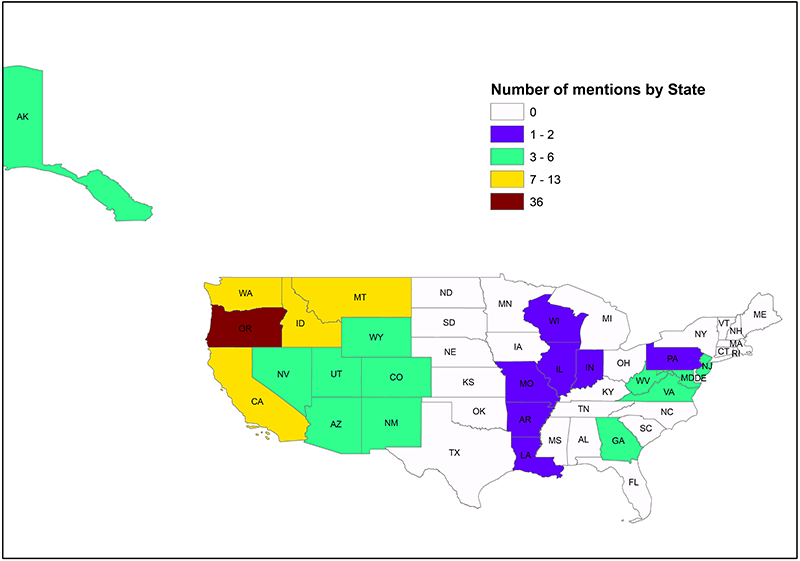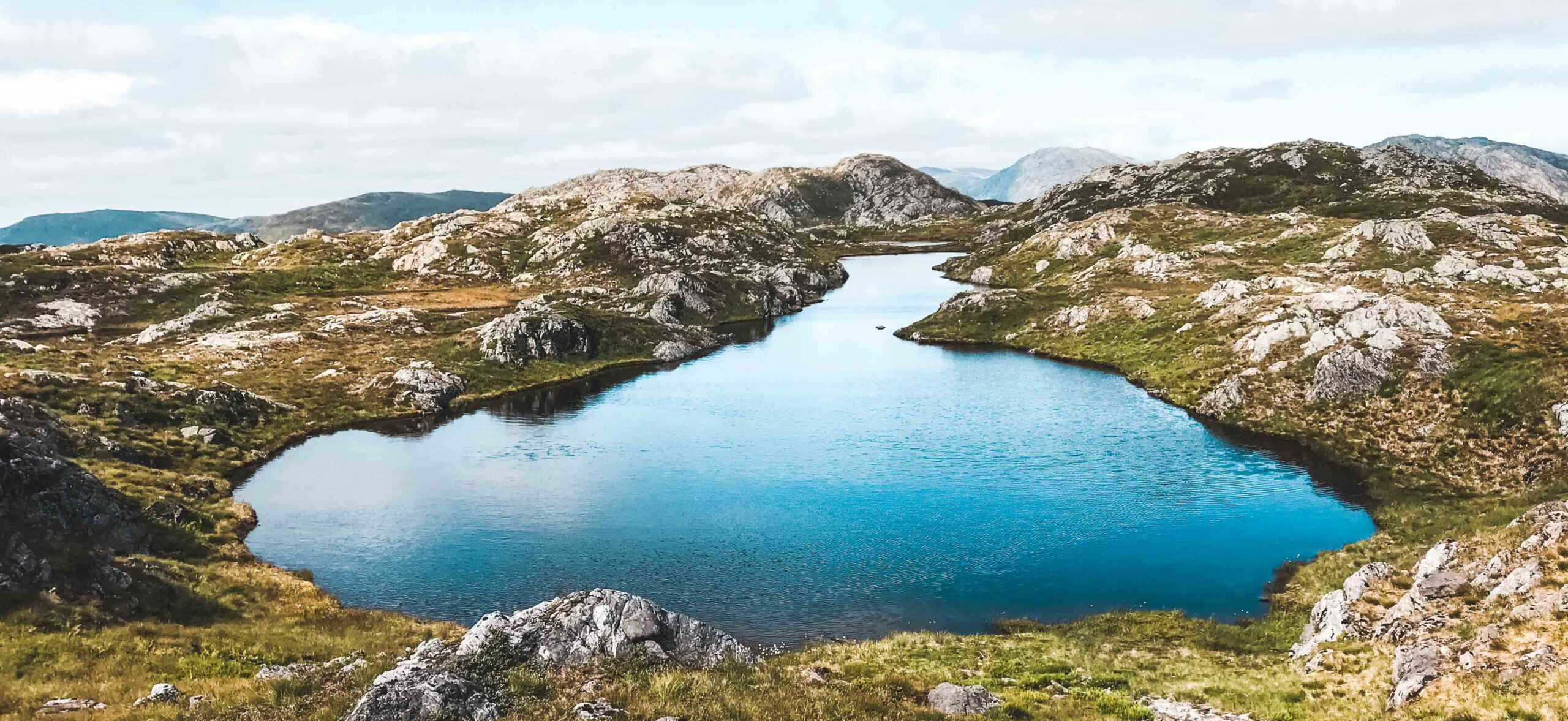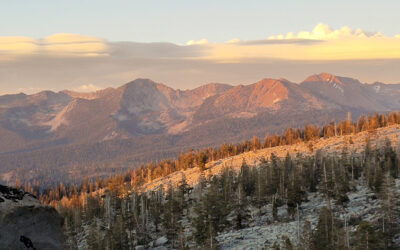Hiker with a large backpack. Photo credit © Jake Melara on Unsplash
Wilderness Shared Stewardship: Exploring Partnerships Through Empathy
Communication & Education
August 2021 | Volume 27, Number 2
Shared stewardship for the National Wilderness Preservation System (NWPS), or the creation of partnerships, is integral to the completion of basic and fundamental stewardship tasks within wilderness (e.g., trail work, Leave No Trace education, monitoring). However, successful wilderness shared stewardship is impeded by a variety of barriers, which are institutional (e.g., employee turnover), practical (e.g., lack of staff, limited informational resources about how to set up partnerships), and conceptual (e.g., ambiguity surrounding what wilderness shared stewardship is). There has been some effort to formally document and understand the challenges, components of success, and solutions within the context of wilderness shared stewardship. However, much of that effort was completed over ten years ago, which highlights a question as to whether previously documented barriers have been addressed.
The goal of this paper is to update the knowledge around the idea of wilderness shared stewardship and to encourage future discussions that foster an empathetic understanding among those engaging in shared stewardship. We suggest that empathy will be critical for success and sustainability of the partnership model. To address these goals, we present findings from surveys and a group empathy exercise implemented during a plenary session at the 2019 National Wilderness Workshop (NWW) in Bend, Oregon, where over 100 workshop participants gathered to discuss shared stewardship.
Wilderness Shared Stewardship
Shared stewardship of the NWPS has been ongoing since the passage of the Act in 1964, as reflected through long-standing partnership organizations such as the Student Conservation Association. More recently, the effort toward collective wilderness stewardship was recognized in the “Ten Year Wilderness Stewardship Challenge” (USDA Forest Service 2004). There are also a few instances of formal documentation and empirical study on shared stewardship. The main findings of these efforts (Table 1) generally highlight basic, and often fundamental, elements that are lacking (e.g., funding, collaboration). Additionally, these efforts highlight resulting barriers (e.g., inflexible funding mechanisms, challenge of building relationships with high turnover) which need to be overcome to develop more success.
While there is a dearth of recent literature on wilderness shared stewardship, the topic of shared stewardship has recently been investigated and articulated in other contexts, including fire management and forest health (USDA Forest Service 2018) and trails management and administration (Boyst 2020; Cerveny, Derrien, and Miller 2020).

Table 1 – A summary of findings previously reported on wilderness shared stewardship

Figure 1 – The empathy exercise at the 2019 National Wilderness Workshop
Empathy in shared stewardship partnerships
Research has shown that empathy, or the “sensing and sharing of feelings of one person by another” (Pavlovich and Krahnke 2012:132), is an integral component of collaborative work (Ansell and Gash 2008; J. R. Hagmann et al. 2002; Wald et al. 2017; Yasmi, Schanz, and Salim 2006). Collaboration is at the core of shared stewardship of the NWPS, and two entities that commonly collaborate, agencies and non-governmental organizations (NGOs), work in very different environments with different tasks and goals. For instance, an NGO focused on providing stewardship crews to agencies may have a mission of empowering youth and young adults, while agency staff who engage those crews are focused on meeting the mission and priorities of the land management agency and current administration. A lack of understanding of that difference can lead to miscommunication and may strain relationships.
Empathy is related to the goals of trust building, shared understanding, and collaborative governance (Pavlovich and Krahnke 2012; J. Hagmann and Chuma 2002). Collaborative governance, according to the commonly cited theory of Ansell and Gash (2008:544), is defined as: “a governing arrangement where one or more public agencies directly engage non-state stakeholders in a collective decision-making process that is formal, consensus-oriented, and deliberative and that aims to make or implement public policy or manage public programs or assets.” In their framework, the collaborative process consists of face-to-face dialogue, trust building, commitment to the process, shared understanding, and intermediate outcomes. These connections between empathy, collaboration, and shared stewardship guided our work as we aimed to create a space where the wilderness community could better understand one another for the benefit of furthering shared stewardship partnerships.
Examining Empathy
As participants convened for the shared stewardship discussion at the 2019 NWW, data collection materials were distributed to all participants. The materials consisted of two separate cards: a survey card and an empathy-exercise card. The survey card had five questions: (1) role (e.g., agency employee, volunteer); (2) geographic location of wilderness stewardship; (3) level of agreement related to whether or not shared stewardship is ‘working’; (4) reasons for why shared stewardship is successful (or not successful) and; (5) innovative ideas related to what might benefit shared stewardship work in the future. The second, empathy-exercise card, asked participants to record things “that cause you worry or anxiety about your job as it relates to shared stewardship”.
The cards were numbered prior to distribution, and everybody in the room was asked to self-organize based on their number (1-10 in a group, 11-20 in a group, etc.). People were then asked to fill in their cards, and then place the cards in two separate piles (survey-card pile, and empathy-card pile). All survey cards were collected, and the groups were asked to rotate so that they arrived at a pile of empathy cards which were not written by anyone in the arriving group. The pile of empathy cards were then read aloud, and each group discussed what was written on the card within the context of wilderness shared stewardship (Figure 1). Groups notes and answers written on both the survey and empathy cards were recorded and coded in terms of common categories and themes.
We categorized the responses of 98 participants into four categories: agency workers, NGO representatives, volunteers, and ‘other’ (e.g., university employees, interested citizens). Within these different categories, there was a range of roles. For instance, within the agency category, there were seasonal workers, program managers, regional and district representation, and national leadership. The diversity of those who participated is also represented in the different areas of the United States where people were engaging in wilderness shared stewardship (Figure 2). Unsurprisingly, given the location of the workshop in Bend, Oregon, the most mentions were of Oregon and its surrounding states.
Generally, participants felt that shared stewardship of the NWPS was working. On a five-point scale from strongly disagree (1) to strongly agree (5), the mean value was 3.68. Around two-thirds of people agreed, either ‘somewhat’ or ‘strongly’, and only 11 people disagreed, either ‘somewhat’ or ‘strongly’. The open-ended survey questions and the empathy exercise conveyed a more detailed understanding of wilderness shared stewardship. These findings are discussed in terms of five themes: (1) culture and community; (2) communication and coordination; (3) practice; (4) capacity; and (5) big, existential issues.

Figure 2 – Map of States mentioned by participants in relation to their shared stewardship work
Culture and community
Perhaps one of the larger assets existing within the context of wilderness management and shared stewardship is the passion of those stewarding wilderness lands. In response to why shared stewardship is working, “passionate people” was a recurring comment. Conversely, issues related to a lack of gratitude, feelings of inadequacy, an ‘elitist’ agency culture, and general trust and relationship issues were expressed by 24 people in the context of that which is impeding shared stewardship. For instance, Participant 36 (NGO) responded that “history of conflict endangers future connections.” Feelings of inadequacy were often mentioned by people both within and outside of the agencies. Participant 35 (NGO) noted that “working with experts in the field gives me imposter syndrome. I don’t know the lingo, acronyms, or really what they’re talking about half the time.” An experienced agency employee in a leadership role replied: “I fear that I am not qualified enough/educated enough to train, supervise interns” (Participant 49).
Under the ‘community’ sub-theme, 31 people made comments that were organized into issues including a lack of inclusivity, uneven community interest (e.g., rural and less popular wilderness areas lacking support), and the need to intentionally broaden how the wilderness community is defined. Sixteen people specifically mentioned the lack of diversity and/or the need from a more representative community. Participant 13 (agency) stated the need to “be intentional about building equity into new policies and ensuring underserved and underrepresented groups are heard.”
Communication And Coordination
Overall, 43 people made comments that were organized into this theme. Communication is a keystone element for the shared stewardship endeavor, as Participant 35 (NGO) stated: “communication leads it one way or another.” Specific to communication, there were calls for increased transparency in decision-making, and better conveyance of knowledge through education and outreach. The importance of communication was clear, in many cases, when people highlighted their main concerns within the context of the empathy exercise. For instance, Participant 46 (agency) stated their main worry or anxiety as: “time commitment required, and lack of understanding/patience from shared stewardship partnerships/volunteers.” This worry suggests from their perspective that partners are not aware of the challenges agency employees face trying to engage in shared stewardship.
Related to communication, a recurring set of comments focused on coordination, or the need to better consolidate and organize efforts related to shared stewardship and wilderness management. For instance, Participant 94 (agency) noted the need for “united leadership”, and Participant 82 (NGO) suggested the need for a “new wilderness entity overall to coordinate all (e.g., the four agencies need wilderness leadership).” Comments were not only in reference to on-the-ground coordination, but they also related to coordination of our understanding of shared stewardship as a concept. There were several who conveyed a lack of understanding about what shared stewardship is generally, and/or what its purpose is specifically. As Participant 98 (volunteer) explained: “I am unsure, as a volunteer in a small wilderness group, what shared stewardship means and how to encourage it.”
Practice
Practice describes those facets of shared stewardship that relate to day-to-day operations. Twenty-two comments organized under this theme highlight inefficiencies that stem both from a lack of clarity on peoples’ roles (and taking advantage of peoples’ particular strengths) and the “duplication of work” (Participant 78, agency). Other comments referenced the need for practical tools such as databases and central locations of information, as well as guides or protocols for improving transparency. The “creation of best practices” (Participant 66, agency) was mentioned, as was an “online system” for sharing resources (Participant 30, agency), a “portal for info dissemination” (participant 8, NGO), or any place to make “data collection public info” (Participant 49, agency). Lastly, we organized comments related to well-known and discussed issues of agency turnover into this theme, as it can lead to the loss of important relationships and institutional knowledge. As Participant 65 noted: “We are dependent on heroes. Good stewardship performance is dependent upon relationships. When people move on, relationships are broken and trust and performance declines.”
Capacity
Comments related to capacity were generally in reference to: (1) a lack of funding, time, personnel, experience, and training (33 people); (2) a concern that an over-reliance on partnerships will lead to less stable agency funding for wilderness (10 people) and; (3) partner capacity (or lack thereof) (5 people). Of these three general comment areas, those related to ‘partner capacity’ may need clarification. These comments often pointed toward one side of the partnership model as deficient. For instance, Participant 34 (agency) noted, “not all areas have willing, competent, capable, and engaged partners”, and Participant 79 (agency) focused specifically on deficiencies associated with ‘advocacy’ by stating: “lacking an organized stewardship group to work with that is not focused on advocacy.” From the non-agency perspective, Participant 52 (NGO) suggested that they would “be much more effective if agency partners had more interest in, or capacity to help make the partnerships work. Coordinating projects with agencies is our #1 problem stopping us from accomplishing more.”
Big, Existential Issues
Comments organized in this theme capture the broad range of concerns facing the wilderness community that extend beyond wilderness. Nine people expressed concerns about politics influencing the ability to steward the lands, whether through an impact on “funding or day-to-day decisions” (Participant 59, agency), or “an administration that does not seem to share our values” (Participant 10, NGO).
Another recurrent concern was the loss, or lack, of values and connection with nature. Specifically, within this context on values, there was the idea that restricting use or charging fees would erode wilderness stewardship. For instance, Participant 63 (volunteer) stated that “restrictions and use limits will not create wilderness stewards or advocates. In fact, it will do the opposite.” Within the specific context of partnering, Participant 92 (agency) stated: “The use fees charged by agencies and the rec.gov transaction fees will hurt agencies ability to be seen as true partners.”
Lastly, participants highlighted the challenge that the shared stewardship model, however defined, is not supported by everyone. Usually, the lack of internal support for shared stewardship was focused on the agencies or, more specifically, agency leaders. These comments were made both by agency personnel concerned that leadership does not prioritize wilderness stewardship, as well as partners concerned that the agencies are not fully committed to partnerships. For instance, one participant stated, “agency partners don’t equally embrace partnerships” (Participant 115, NGO), and yet another cited a “resistance to a shared stewardship model” (Participant 73, agency).
The Conversation Going Forward
Lived Experience Related To Partnerships
Five non-agency participants noted a feeling of not being valued (something also noted by Myers and Hunger (2006)), and nine agency participants noted that they felt misunderstood or that they lacked the time or ability to clearly convey an overwhelming workload. This suggests, primarily, a need for increasing awareness among the wilderness community about peoples’ lived experiences. Such awareness may highlight tractable solutions or, at the very least, tractable first steps. For example, changing the perception of a non-agency partner, who might view an agency employee as aloof or unengaged within the context of a partnership, may be as simple as conveying the current workload of tasks that is leading to a lack of ability to contribute time to a partnership. Similarly, if providing tokens of appreciate to volunteers (e.g., travel reimbursement, snacks) is not possible, then articulating such impediments may be worthwhile. Of course, continuing the conversation is critical to understand how volunteers are specifically feeling underappreciated, or in what ways agency personnel feel that their jobs are not clearly understood by the general public.
Sharing feelings through open conversations may help members of a partnership unite around a common passion for wilderness, whereby relationships become stronger through an empathetic understanding of the challenges, as well as an understanding that members care deeply for the wilderness resource.
We suggest that conversations between agency and non-agency partners, even when related to the minutiae of everyday work life, can foster empathy among those involved. These conversations may not only highlight elements of the partnership that are impeding progress (e.g., a lack of time or funding), but they can facilitate getting to know the person behind the stewardship role. Sharing feelings through open conversations may help members of a partnership unite around a common passion for wilderness, whereby relationships become stronger through an empathetic understanding of the challenges, as well as an understanding that members care deeply for the wilderness resource.
Indicators Of Success, Incentive Structures, And The Meaning Of Shared Stewardship
It is notable that there is a lack of understanding between shared stewardship entities (agencies and NGOs) about the pressures, and indicators of success. For instance, agencies are often facing pressure to increase the scope of completed projects in wilderness, which can lead to requests for partners to contribute staff time. However, budgetary restrictions may make agency funding of partner staff time challenging. Additionally, the respective missions of partner organizations may influence perspectives of what successful stewardship looks like (e.g., miles of trail maintained may be secondary to teaching youth life skills). Clearly communicating these differences appears to be important for joint priority setting.
With better communication, it may also be possible to better understand the exact meaning of shared stewardship within the wilderness context, as well as how different roles may be most effective. Several people mentioned a lack of clarity about the meaning of shared stewardship, or how to encourage it among volunteers. Additionally, it was noted that, for instance, that the role of science within the context of shared stewardship was unclear. Therefore, one goal of a continued discussion surrounding shared stewardship would be to develop a basic primer about the effort.
Communication and clear definition of shared stewardship could create a better understanding of fundamentals related to the partnership model. For instance, Day (2011) highlighted the point made by an agency partner, who stated that wilderness shared stewardship constitutes a cooperative partnership rather than a collaborative partnership, as the decision-making power remains with the agency. While distinguishing between cooperative and collaborative partnerships may be challenging, the point that the agency side of the partnership generally has final say is important.
Perhaps a better distinction would be between collaborative governance, as described above (which does require an assessment of power differences), and co-governance, which implies a level of equal decision-making power. Collaborative governance relationships, as defined herein, may have unequal distribution of decision-making power. Indeed, federal land management agencies, may be legally restricted from transferring the decision-making power to non-federal entities. However, with the recognition that ownership in the shared stewardship process is both critical and tied to decision-making power, as wilderness shared stewardship evolves, there may be opportunities to increase a sense of decision-making ownership on the part of agency partners. For instance, while under current laws and policies, agencies are the ultimate decision-makers with regard to the type or scope of projects being completed, shared stewardship could be formalized in a way that provides partners with decision-making power with regard to how a program or project is implemented within shared stewardship contexts?
While power disparity can complicate relationships, mitigating potential complications likely comes with a better understanding of what is possible (and not possible) within shared stewardship contexts. Clear communication about roles and expectations may facilitate a feeling of shared ownership over the stewardship process. A belief that such roles are not well defined was evident in the following comment by Participant 4 (NGO): “I’m concerned that our partner group has been forced to take on too many decisions which should be agency-driven.” This highlights a need to ensure that non-agency partners within the shared stewardship model are recognized as integral entities who can provide a unique set of skills and, therefore, are an important supplement to agency work. In other words, even if funds for wilderness stewardship were limitless, partnerships with non-agency entities would still be critical to the future of the NWPS. For instance, given the high turnover and career incentives that result in frequent relocations within the federal agencies, non-federal partners may represent a more stable, place-based source of wilderness knowledge.
When combining these recommendations for focusing the conversation around shared stewardship with the suggested need for more shared understanding and empathy, we conclude with a suggestion for what shared stewardship means, as an ideal. In practice, shared stewardship means sharing empathy, learning, risk, reward, opportunity, failure, and success across organizational divides. It starts from a place of curiosity, humility, and openness. There are fundamental questions inherent to the shared stewardship process, including: What do we know about this resource, it’s current condition, the context within which it exists and will exist over time, and the condition we hope to leave it in for the future? What ideas do we have in common; what differences of opinion and position do we represent? What are our hopes and fears? And, if we moved forward together to maximize hope and minimize fear, what good could we effect? Of course, it is recognized that legal frameworks often vest decision making authority with a single entity– usually a federal agency. However, shared stewardship realizes that the impact of these decisions is felt over the interrelated whole and seeks to invite that whole to engage in the totality of the decision-making process, including owning the risk and reward of acting and supporting each other as an interrelated community.
About the Authors
CHRISTOPHER A. ARMATAS is a research social scientist at the Aldo Leopold Wilderness Research Institute, USDA Forest Service; email: christopher.armatas@usda.gov
JIMMY GAUDRY is the Wilderness and Wild & Scenic River program manager, Northern Region, USDA Forest Service; email: jimmy.gaudry@usda.gov
BILL HODGE is the executive director of the Bob Marshall Wilderness Foundation; email: billhodge@bmwf.org
HEATHER MACSLARROW is the executive director of the Society for Wilderness Stewardship; email: h.macslarrow@wildernessstewardship.org
MICHELLE MITCHELL is the director of Recreation, Wilderness, Heritage, and Volunteer Resources, Southern Region, USDA Forest Service; email: michelle.mitchell2@usda.gov
NANCY TAYLOR is the Wilderness, Wild & Scenic Rivers, Congressionally Designated Areas program manager, Pacific Northwest Region, USDA Forest Service; email: nancy.taylor@usda.gov
References
Ansell, C., and A. Gash. 2008. Collaborative Governance in Theory and Practice. Journal of Public Administration Research and Theory 18(4): 543–571. doi:10.1093/jopart/mum032 %J Journal of Public Administration Research and Theory.
Boyst, B. 2020. With Collaboration We Can Overcome Challenges Together. International Journal of Wilderness 26(2): 12–15.
Cerveny, L. K., M. M. Derrien, and A. B. Miller. 2020. Shared Stewardship and National Scenic Trails: Building on a Legacy of Partnerships. International Journal of Wilderness 26(2): 18–33.
Day, H. 2011. Developing Successful Wilderness Stewardship Partnerships (Professional Paper). Environmental Studies. Missoula, MT: The University of Montana. doi:Available at URL: https://scholarworks.umt.edu/etd/309/.
Hagmann, J., and E. Chuma. 2002. Enhancing the Adaptive Capacity of the Resource Users in Natural Resource Management. Agricultural Systems 73: 23–39. doi:10.1016/S0308-521X(01)00098-1.
Hagmann, J. R., E. Chuma, K. Murwira, M. Connolly, and P. Ficarelli. 2002. Success Factors in Integrated Natural Resource Management R & D Lessons from Practice. Conservation Ecology 5(2): 29.
Myers, C. G., and D. Hunger. 2006. Components of and Barriers to Building Successful Interagency Wilderness Citizen Stewardship Programs. International Journal of Wilderness 12(3): 33–36.
Pavlovich, K., and K. Krahnke. 2012. Empathy, Connectedness and Organisation. Journal of Business Ethics 105(1): 131–137. doi:10.1007/s10551-011-0961-3.
USDA Forest Service. 2004. Wilderness Stewardship: 10-Year Wilderness Stewardship Challenge. Washington, DC. doi:Available at URL: https://winapps.umt.edu/winapps/media2/wilderness/NWPS/documents/FS/10YWSC%20Brochure.pdf.
USDA Forest Service. 2018. Toward Shared Stewardship across Landscapes: An Outcome-Based Investment Strategy. Washington DC. doi:Available at URL: https://www.fs.usda.gov/sites/default/files/toward-shared-stewardship.pdf.
Wald, D. M., E. A. Segal, E. W. Johnston, and A. Vinze. 2017. Understanding the Influence of Power and Empathic Perspective-Taking on Collaborative Natural Resource Management. Journal of Environmental Management 199: 201–210. doi:https://doi.org/10.1016/j.jenvman.2017.05.030.
Wilderness Advisory Group. 2009. Creating Shared Stewardship of the Wilderness Resource through Partnerships and Volunteers: The Top 10 Partnership Challenges and Solutions. Unpublished Report: Forest Service. doi:Available at URL: https://winapps.umt.edu/winapps/media2/wilderness/NWPS/documents/FS/2009_partnerships_challenges_solutions.pdf.
Yasmi, Y., H. Schanz, and A. Salim. 2006. Manifestation of Conflict Escalation in Natural Resource Management. Environmental Science & Policy 9(6): 538–546. https://edepot.wur.nl/44595.
Read Next
Ambition: The Power of a Big Idea and Sticking to it
Protecting Half of Earth’s land and seas requires the power of persistence, truth and relationships.
Preserving the Wildness of Wilderness in the Anthropocene
Wildness: What is this evocative and elusive, primal and unquantifiable quality of Wilderness? Why is it so threatened in the non-analogue future we face? Why and how should we perpetuate it?
The Evolution Of Management Science To Inform Carrying Capacity Of Overnight Visitor Use In The Yosemite Wilderness
To avert overcrowding, mitigate biophysical impacts, and ensure quality wilderness experiences, managers utilize a suite of management tools, including inventories and assessments of wilderness campsite and social conditions, to evaluate changes to use and condition over time.



